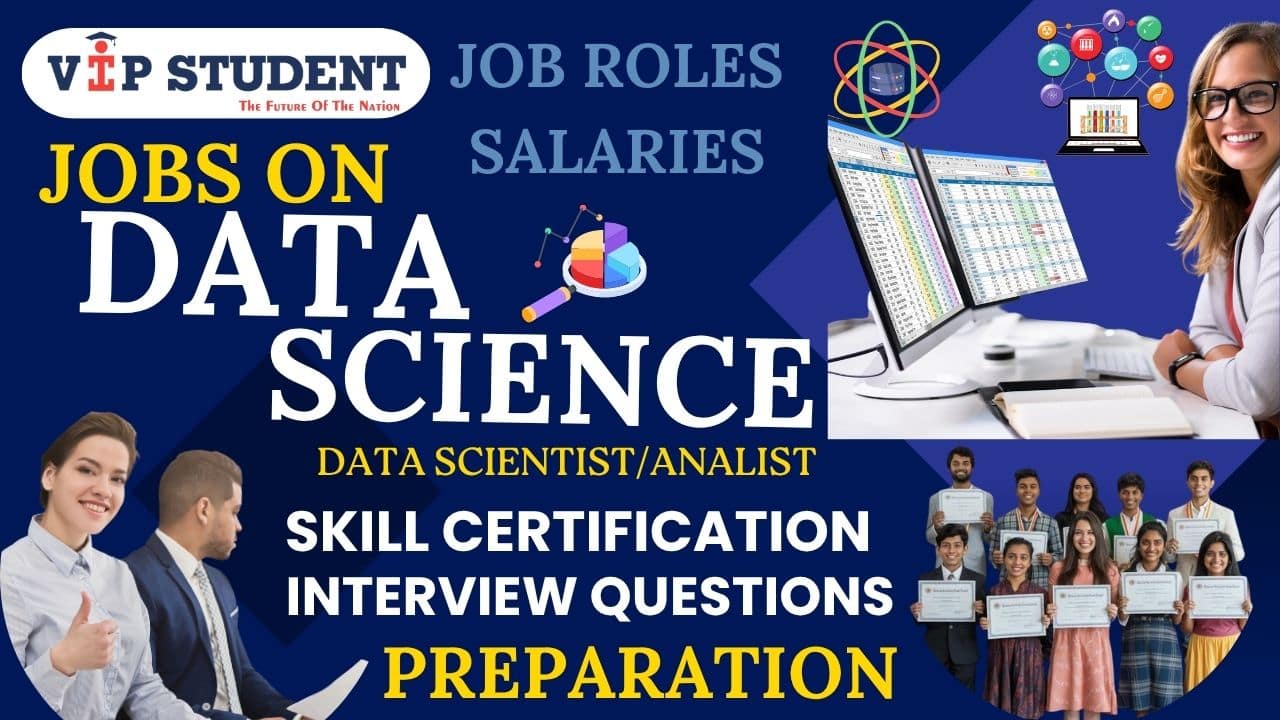LET’S KNOW ABOUT JOBS ON DATA SCIENCE, JOB ROLES, SALARY PARTUCULARS, PRACTICE INTERVIEW QUESTIONS AND CAREER OPPORTUNITES AND GET CERTIFIED ON YOUR DATA SCIENCE SKILLS
JOBS ON DATA SCIENCE: In today’s data-driven world, Data Science has emerged as one of the most sought-after career fields. From tech giants to startups, companies are heavily investing in data scientists to make informed business decisions. Whether you’re a fresh graduate or a working professional looking to switch careers, Data Science offers exciting and high-paying job opportunities.
Data Science is an interdisciplinary field that uses scientific methods, algorithms, and systems to extract knowledge and insights from structured and unstructured data. It blends statistics, computer science, machine learning, and domain expertise to interpret and solve real-world problems using data.
Career in Data Science:
- High demand across multiple industries
- Lucrative salaries and global job opportunities
- Flexible working (remote, hybrid, freelance)
- Constant learning and innovation
- Opportunities to work on real-world impactful problems
Top Job Roles in Data Science and Career Opportunites:
1. Data Scientist
- Extracts insights from large datasets using algorithms and statistical techniques.
- Builds predictive models and reports.
- Works with cross-functional teams to solve business problems.
2. Data Analyst
- Analyzes data trends, creates visual dashboards, and prepares business reports.
- Uses tools like Excel, SQL, Power BI, and Tableau.
- Ideal for beginners or entry-level professionals.
3. Machine Learning Engineer
- Designs and deploys machine learning models.
- Works with Python, TensorFlow, PyTorch, and big data platforms.
- Requires strong programming and math skills.
4. Data Engineer
- Builds data pipelines and manages data infrastructure.
- Works with tools like Hadoop, Spark, Kafka, and AWS/GCP/Azure.
- Focuses more on backend and data architecture.
5. Business Intelligence (BI) Analyst
- Uses BI tools to turn data into actionable insights.
- Works closely with business teams to identify growth opportunities.
- Uses Power BI, Looker, or QlikView.
6. AI/Deep Learning Engineer
- Specializes in building neural networks for speech, vision, and NLP tasks.
- Works with large datasets and GPUs.
Skills Required for Data Science Jobs
To succeed in data science, you need both technical and analytical skills.
Technical Skills
- Programming Languages: Python, R, Java, or Scala
- Data Manipulation: Pandas, NumPy
- Data Visualization: Matplotlib, Seaborn, Tableau, Power BI
- Machine Learning: Scikit-learn, TensorFlow, Keras, XGBoost
- Databases: SQL, MongoDB
- Big Data Technologies: Hadoop, Spark
- Cloud Platforms: AWS, GCP, Azure
Analytical and Soft Skills
- Strong statistical and mathematical knowledge
- Problem-solving mindset
- Business acumen
- Communication and storytelling using data
- Team collaboration
Educational Background
While many data scientists have degrees in Computer Science, Mathematics, Statistics, Engineering, or Economics, it is also possible to enter this field through online learning and certifications.
Common Education Paths:
- Bachelor’s Degree (B.Sc, B.Tech, B.E)
- Master’s Degree (M.Sc, M.Tech, MBA – Analytics)
- Online Certifications:
- Google Data Analytics Certificate
- IBM Data Science Professional Certificate
- Coursera, edX, Udacity Nanodegrees
- Simplilearn, DataCamp, and NPTEL courses (for Indian learners)
Salaries in Data Science
Data Science offers some of the highest-paying jobs in the tech industry.
| Experience Level | Role | Average Salary (India) | Average Salary (US) |
|---|---|---|---|
| Entry-Level | Data Analyst | ₹4 – ₹7 LPA | $60,000 – $90,000 |
| 2–5 Years | Data Scientist | ₹8 – ₹15 LPA | $100,000 – $130,000 |
| 5–10 Years | Senior Data Scientist | ₹18 – ₹30+ LPA | $140,000+ |
| 10+ Years | Chief Data Officer | ₹40 LPA+ | $200,000+ |
Note: Salaries vary based on skills, company, and location.
Industries Hiring Data Science Professionals
Data Science is not limited to tech companies. Today, almost every industry uses data analytics.
Top Hiring Sectors:
- Information Technology (IT)
- Banking & Financial Services
- Healthcare & Pharmaceuticals
- Retail & E-commerce
- Education & EdTech
- Telecom
- Manufacturing & Supply Chain
- Media & Entertainment
- Government and Research Agencies
Top Companies Hiring Data Scientists
Here are some top recruiters:
- Amazon
- Microsoft
- Facebook (Meta)
- IBM
- Infosys
- TCS
- Accenture
- Deloitte
- Flipkart
- JPMorgan Chase
🔹 Remote Job Boards:
- Remote OK
- We Work Remotely
- AngelList
- FlexJobs
Career Growth Path in Data Science
A typical growth path looks like this:
- Intern / Junior Data Analyst
- Data Analyst / Junior Data Scientist
- Data Scientist / BI Developer
- Senior Data Scientist / ML Engineer
- Data Science Manager / Product Analyst Lead
- Director of Data Science / Chief Data Officer (CDO)
With more experience, data scientists can move into leadership roles, strategy, or even start their own consulting firms.
Get Started:
Step-by-Step Guide:
- Learn the Basics – Python, statistics, SQL
- Take Online Courses – Enroll in reputed platforms
- Work on Projects – Upload your work to GitHub or Kaggle
- Build a Portfolio – Showcase dashboards, models, and visualizations
- Get Certified – Add recognized credentials to your resume
- Apply for Internships – Gain hands-on experience
- Network – Join LinkedIn groups, forums, and attend webinars
Challenges in Data Science Careers
While the career is rewarding, it also comes with its share of challenges:
- Managing unstructured or messy data
- Constant need to update skills
- Complex algorithms and mathematical understanding
- Working with incomplete or noisy datasets
- Aligning data insights with business goals
Data Science Interview Questions and Answers
🔹 General & Conceptual
1. What is Data Science?
Answer: Data Science is an interdisciplinary field that uses algorithms, statistics, and machine learning to extract insights from data and support decision-making.
2. How is Data Science different from Data Analytics?
Answer: Data Analytics focuses on analyzing existing data to generate insights, while Data Science includes building models, predictions, and machine learning applications.
3. What is the CRISP-DM methodology?
Answer: It stands for Cross Industry Standard Process for Data Mining and includes Business Understanding, Data Understanding, Data Preparation, Modeling, Evaluation, and Deployment.
4. What is the role of a Data Scientist in a company?
Answer: A Data Scientist analyzes complex data, builds models, and delivers insights that help in strategic business decisions.
5. What are some popular applications of Data Science?
Answer:Fraud detection, recommendation systems, customer segmentation, predictive maintenance, and image recognition.
🔹 Statistics & Probability
6. What is the difference between mean, median, and mode?
Answer: Mean is the average, median is the middle value, and mode is the most frequent value in a dataset.
7. Explain p-value in simple terms.
Answer: P-value measures the probability of observing results under the null hypothesis. A small p-value (<0.05) indicates strong evidence against the null hypothesis.
8. What is standard deviation?
Answer: It measures how spread out the values in a dataset are from the mean.
9. What is correlation?
Answer: It measures the relationship between two variables. Values range from -1 (negative) to +1 (positive).
10. What is the Central Limit Theorem?
Answer: It states that the distribution of sample means approaches a normal distribution as the sample size increases.
🔹 Programming & Tools
11. Which programming languages are used in Data Science?
Answer: Python, R, SQL, Scala, and sometimes Java.
12. What are some Python libraries used in Data Science?
Answer: NumPy, Pandas, Scikit-learn, TensorFlow, Matplotlib, and Seaborn.
13. How do you handle missing data?
Answer: Techniques include deletion, mean/median imputation, forward-fill, backward-fill, or using predictive models.
14. What is data normalization?
Answer: It’s a technique to scale data within a specific range, usually 0 to 1, to ensure better model performance.
15. What is EDA (Exploratory Data Analysis)?
Answer: EDA involves visualizing and summarizing datasets to understand patterns, detect outliers, and identify relationships.
🔹 Machine Learning
16. What is the difference between supervised and unsupervised learning?
Answer: Supervised learning uses labeled data for prediction; unsupervised learning finds hidden patterns without labeled data.
17. What is overfitting in machine learning?
Answer: Overfitting happens when a model performs well on training data but poorly on new, unseen data.
18. What is cross-validation?
Answer: A technique to split data into training and testing sets multiple times to evaluate model performance more reliably.
19. What is a confusion matrix?
Answer: A table used to describe classification model performance—shows true/false positives and negatives.
20. What is the difference between classification and regression?
Answer: Classification predicts categories (e.g., spam/not spam); regression predicts continuous values (e.g., price).
🔹 Algorithms & Models
21. Explain Linear Regression.
Answer: Linear Regression predicts a target value using a straight line based on the relationship between input and output variables.
22. What is Logistic Regression?
Answer: A statistical model used for binary classification problems using a sigmoid function to output probabilities.
23. How does a Decision Tree work?
Answer: It splits the dataset into branches based on decision rules, forming a tree structure for predictions.
24. What is Random Forest?
Answer: An ensemble method that combines multiple decision trees to improve accuracy and prevent overfitting.
25. What is k-NN (k-Nearest Neighbors)?
Answer: A classification algorithm that assigns labels based on the closest data points in the feature space.
🔹 Deep Learning & AI
26. What is Deep Learning?
Answer: A subset of ML using neural networks with multiple layers to analyze complex patterns like images, speech, and text.
27. What is a neural network?
Answer: A network of artificial neurons that mimic the human brain to process and learn from data.
28. What is the role of activation functions?
Answer: They introduce non-linearity into the network, enabling it to learn complex functions.
29. What is CNN (Convolutional Neural Network)?
Answer: A deep learning model specialized for processing image data by capturing spatial features.
30. What is overfitting in deep learning and how to prevent it?
Answer: Use dropout, early stopping, and regularization techniques to reduce overfitting in neural networks.
🔹 SQL & Databases
31. What is the difference between WHERE and HAVING clauses?
Answer: WHERE filters rows before grouping; HAVING filters groups after aggregation.
32. How do you find duplicates in a SQL table?
Answer: Use GROUP BY and HAVING COUNT(*) > 1.
33. What is normalization in databases?
Answer: Organizing data to reduce redundancy and improve data integrity.
34. What is a JOIN in SQL?
Answer: It combines rows from two or more tables based on related columns.
35. Write a query to get the top 5 highest-paid employees.
Answer:
SELECT * FROM employees ORDER BY salary DESC LIMIT 5;
🔹 Business & Behavioral
36. How would you explain a complex model to a non-technical audience?
Answer: Use simple language, visuals, and analogies focusing on how it solves business problems.
37. What are your strengths as a data professional?
Answer: Problem-solving skills, analytical thinking, attention to detail, and curiosity.
38. Describe a challenging project and how you handled it.
Answer: [Customizable] Talk about a project with messy data and how you cleaned and modeled it to deliver useful insights.
39. How do you handle tight deadlines?
Answer: I prioritize tasks, use efficient tools, and focus on key deliverables without compromising quality.
40. How do you ensure your findings are actionable for business?
Answer: I align my analysis with business goals and present results in an understandable, decision-friendly format.
🔹 Career-Specific
41. Why did you choose Data Science as a career?
Answer: I enjoy solving real-world problems using data and continuously learning new tools and techniques.
42. What is your experience with dashboards?
Answer: I’ve created dashboards using Tableau, Power BI, and Python to present insights and KPIs.
43. How do you stay updated with the latest trends in Data Science?
Answer: I follow blogs (Towards Data Science, Analytics Vidhya), take online courses, and read research papers.
44. What makes a good data science project?
Answer: Clear problem definition, clean data, robust analysis, and actionable insights.
45. What kind of data science problems interest you the most?
Answer: I’m most interested in predictive modeling, recommendation systems, and NLP applications.
🔹 Final Round Questions
46. What is your preferred IDE or toolset for Data Science?
Answer: Jupyter Notebook, VS Code, Google Colab, and Tableau for visualization.
47. Have you worked with cloud platforms?
Answer: Yes, I’ve used AWS (S3, EC2), Google Cloud (BigQuery), and Azure ML for deploying models.
48. What is A/B testing?
Answer: A/B testing compares two versions of a product or feature to determine which performs better.
49. What is data leakage in machine learning?
Answer: It occurs when information from outside the training dataset is used to create the model, leading to overfitting.
50. What are your future goals as a data scientist?
Answer: To lead impactful projects, mentor aspiring data professionals, and contribute to innovation in AI and ML.
Practical Data Science Interview Questions and Answers
🔹 Data Cleaning & Preprocessing
1. Q: How do you handle missing values in a dataset?
A: I use techniques like dropping rows, mean/median imputation for numerical data, or mode/constant replacement for categorical features, depending on the situation.
2. Q: How can you remove duplicate rows in a Pandas DataFrame?
A:
df = df.drop_duplicates()
3. Q: How do you identify outliers using the IQR method?
A:
Q1 = df['column'].quantile(0.25)
Q3 = df['column'].quantile(0.75)
IQR = Q3 - Q1
outliers = df[(df['column'] < Q1 - 1.5*IQR) | (df['column'] > Q3 + 1.5*IQR)]
4. Q: What is normalization and when is it needed?
A: Normalization scales data between 0 and 1 using MinMaxScaler. It is essential for algorithms like KNN and neural networks.
5. Q: How do you handle categorical variables with many levels?
A: Use techniques like frequency encoding, target encoding, or dimensionality reduction methods like PCA if appropriate.
🔹 Exploratory Data Analysis (EDA)
6. Q: How do you detect skewness in numerical data?
A: Use df.skew() in Pandas or visualize with histograms or boxplots.
7. Q: How do you check correlations in a dataset?
A:
df.corr()
# or visualize
sns.heatmap(df.corr(), annot=True)
8. Q: What plot is best for comparing distributions between groups?
A: Boxplots or violin plots.
9. Q: How do you find the most frequent values in a column?
A:
df['column'].value_counts().head()
10. Q: What tool do you use to identify missing values?
A:
df.isnull().sum()
🔹 Feature Engineering
11. Q: What is one-hot encoding?
A: It converts categorical variables into binary vectors using pd.get_dummies().
12. Q: How do you extract the month from a datetime column?
A:
df['month'] = pd.to_datetime(df['date_column']).dt.month
13. Q: How do you handle multicollinearity?
A: Remove or combine correlated features, or use regularization techniques like Lasso.
14. Q: When would you use label encoding?
A: For ordinal categorical variables where order matters.
15. Q: What is feature scaling and why is it needed?
A: It standardizes input values to a uniform range to help models converge faster.
🔹 Model Building
16. Q: How do you train a logistic regression model?
A:
from sklearn.linear_model import LogisticRegression
model = LogisticRegression()
model.fit(X_train, y_train)
17. Q: What is hyperparameter tuning?
A: It optimizes model performance using tools like GridSearchCV or RandomizedSearchCV.
18. Q: What are the steps in building a machine learning model?
A: Data preprocessing → Feature selection → Model selection → Training → Evaluation → Deployment.
19. Q: How do you choose the right algorithm?
A: Based on data size, structure, model interpretability, and accuracy requirements.
20. Q: What is the role of a validation set?
A: It helps in tuning hyperparameters and avoids overfitting on the training set.
🔹 Model Evaluation
21. Q: What is the confusion matrix?
A: A table showing true positives, false positives, true negatives, and false negatives.
22. Q: How do you calculate F1-score?
A:
from sklearn.metrics import f1_score
f1_score(y_true, y_pred)
23. Q: What is ROC-AUC?
A: A performance metric for classification, measuring the trade-off between sensitivity and specificity.
24. Q: What metric do you use for regression?
A: RMSE, MAE, R² score.
25. Q: How do you use k-fold cross-validation?
A:
from sklearn.model_selection import cross_val_score
cross_val_score(model, X, y, cv=5)
🔹 Algorithms & Use Cases
26. Q: How does KNN work?
A: It finds the k closest data points in feature space and uses their majority class or average for prediction.
27. Q: What’s the advantage of Random Forest?
A: It reduces overfitting and increases accuracy by combining multiple decision trees.
28. Q: When to use clustering?
A: When you want to segment users or group data without labeled output.
29. Q: What is overfitting?
A: A model that performs well on training data but poorly on new data due to learning noise.
30. Q: How do you prevent overfitting?
A: Use cross-validation, regularization, pruning (in trees), or dropout (in deep learning).
🔹 SQL for Data Science
31. Q: How do you get unique values from a column in SQL?
A:
SELECT DISTINCT column_name FROM table;
32. Q: Write a SQL query to get the top 5 earning employees.
A:
SELECT * FROM employees ORDER BY salary DESC LIMIT 5;
33. Q: How do you join two tables in SQL?
A:
SELECT * FROM A
JOIN B ON A.id = B.id;
34. Q: What is GROUP BY used for?
A: To group rows based on a column and apply aggregate functions like SUM, COUNT.
35. Q: How do you count NULL values in SQL?
A:
SELECT COUNT(*) FROM table WHERE column IS NULL;
🔹 Python & Libraries
36. Q: How do you merge two DataFrames in Pandas?
A:
merged = pd.merge(df1, df2, on='key')
37. Q: What is the difference between apply() and map()?
A: map() works on Series, apply() works on DataFrames and Series with custom functions.
38. Q: How do you group data and calculate aggregate statistics?
A:
df.groupby('category')['value'].mean()
39. Q: How do you visualize missing data?
A: Use missingno or seaborn.heatmap(df.isnull()).
40. Q: What is the purpose of the sklearn.pipeline module?
A: It helps chain preprocessing and modeling steps for reproducible workflows.
🔹 Model Deployment
41. Q: How do you save a model in Python?
A:
import joblib
joblib.dump(model, 'model.pkl')
42. Q: How do you load a saved model?
A:
model = joblib.load('model.pkl')
43. Q: What tools do you use for deployment?
A: Flask, FastAPI, Streamlit, AWS SageMaker, or Docker.
44. Q: What is model drift?
A: When a model’s performance degrades over time due to changes in data patterns.
45. Q: How do you schedule a batch prediction job?
A: Using tools like Airflow or Cron jobs integrated with Python scripts.
🔹 Business & Communication
46. Q: How do you explain your model to non-technical stakeholders?
A: Use simple language, visuals, and focus on the business impact.
47. Q: How do you choose metrics for success?
A: Based on the business goal—e.g., precision for fraud detection, recall for disease diagnosis.
48. Q: What’s your approach to a new data science project?
A: Understand business goals → gather data → clean → model → validate → present findings.
49. Q: How do you stay updated in the data science field?
A: By following blogs, taking online courses, and participating in competitions (Kaggle).
50. Q: What are your favorite Python libraries for EDA?
A: Pandas, Seaborn, Matplotlib, Sweetviz, and Pandas Profiling.
GENERAL JOB INTERVIEW QUESTIONS AND SAMPLE ANSWERS
1. Tell me about yourself.
General Answer:
you have to tell about your self minimum 3 to 5 minits – Tell about your personal details like your name , parents and siblings and what they do , your location and its famous for, your acadamics like your school name, college name and mention marks you are obtained in 10th class, intermediate, graduation, post graduation (as per your education) and your school or college known for, your certification cources, your projects, your achivements , your tallents, your hobbies and skills you are good at like communication, problem-solving, and teamwork.
And conclude with “I’m looking forward to contributing my skills and strengths to a great/new organization while continuing to learn new skills and to develope my strengths.”
2. What are your strengths?
General Answer:
“My strengths include being organized, reliable, and a quick learner. I’m also good at working with others and staying calm under pressure.”
3. What is your greatest weakness?
General Answer:
“Sometimes I focus too much on details because I want everything to be perfect. However, I’ve been working on managing my time better and knowing when to move on to the next task.”
4. Why do you want to work here?
General Answer:
“I’ve heard positive things about the company’s culture and growth opportunities. I’m excited about the chance to work in an environment that values learning and teamwork.”
5. Why should we hire you?
General Answer:
“I believe I can bring value through my work ethic, adaptability, and eagerness to learn. I’m confident I can quickly become a productive member of your team.”
6. Where do you see yourself in 5 years?
General Answer:
“In five years, I hope to be in a position where I’ve gained more experience, taken on new challenges, and grown professionally within the company.”
7. Describe a challenge you’ve faced and how you handled it.
General Answer:
“I faced a situation where deadlines were tight and priorities were shifting. I stayed focused, managed my time well, and communicated clearly with my team, which helped us complete the project successfully.”
8. How do you handle stress and pressure?
General Answer:
“I try to stay calm and focused by organizing my tasks and taking short breaks when needed. I also talk to teammates or supervisors if I need support.”
9. Do you prefer to work independently or in a team?
General Answer:
“I’m comfortable with both. I enjoy collaborating and learning from others, but I can also stay focused and productive when working on my own.”
10. Do you have any questions for us?
General Answer:
“Yes, I’d like to know more about the daily responsibilities of the role and what the team culture is like.”
JOBS ON DATA SCIENCE Conclusion:
Data Science is more than just a trend — it’s a powerful career path that offers excellent pay, dynamic work, and global demand. If you enjoy solving problems with data, working with technology, and continuously learning, a career in Data Science can be the right choice for you. Now is the best time to explore this field, upgrade your skills, and step into one of the most promising professions of the 21st century.






